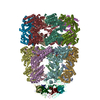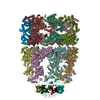[English] 日本語
 Yorodumi
Yorodumi- EMDB-2326: Visualizing GroEL/ES in the Act of Encapsulating a Non-Native Sub... -
+ Open data
Open data
- Basic information
Basic information
| Entry | Database: EMDB / ID: EMD-2326 | |||||||||
|---|---|---|---|---|---|---|---|---|---|---|
| Title | Visualizing GroEL/ES in the Act of Encapsulating a Non-Native Substrate Protein | |||||||||
 Map data Map data | Symmetry-free 3D reconstruction of the bullet-shaped substrate-encapsulated subpopulation sorted from the heterogeneous sample of EL43Py reacted with the substrate protein RuBisCO, GroES and nucleotide ATP | |||||||||
 Sample Sample |
| |||||||||
 Keywords Keywords | protein folding / chaperonin / GroEL / GroEL-GroES / cryo-EM / heterogeneity / substrate / RuBisCO / encapsulation | |||||||||
| Function / homology |  Function and homology information Function and homology informationGroEL-GroES complex / chaperonin ATPase / virion assembly / : / isomerase activity / protein folding chaperone / ATP-dependent protein folding chaperone / response to radiation / unfolded protein binding / protein folding ...GroEL-GroES complex / chaperonin ATPase / virion assembly / : / isomerase activity / protein folding chaperone / ATP-dependent protein folding chaperone / response to radiation / unfolded protein binding / protein folding / protein-folding chaperone binding / response to heat / protein refolding / magnesium ion binding / ATP hydrolysis activity / ATP binding / metal ion binding / identical protein binding / membrane / cytosol Similarity search - Function | |||||||||
| Biological species |   Rhodospirillum rubrum (bacteria) / synthetic construct (others) Rhodospirillum rubrum (bacteria) / synthetic construct (others) | |||||||||
| Method | single particle reconstruction / cryo EM / Resolution: 9.2 Å | |||||||||
 Authors Authors | Chen D-H / Madan D / Weaver J / Lin Z / Schroder GF / Chiu W / Rye HS | |||||||||
 Citation Citation |  Journal: Cell / Year: 2013 Journal: Cell / Year: 2013Title: Visualizing GroEL/ES in the act of encapsulating a folding protein. Authors: Dong-Hua Chen / Damian Madan / Jeremy Weaver / Zong Lin / Gunnar F Schröder / Wah Chiu / Hays S Rye /  Abstract: The GroEL/ES chaperonin system is required for the assisted folding of many proteins. How these substrate proteins are encapsulated within the GroEL-GroES cavity is poorly understood. Using symmetry- ...The GroEL/ES chaperonin system is required for the assisted folding of many proteins. How these substrate proteins are encapsulated within the GroEL-GroES cavity is poorly understood. Using symmetry-free, single-particle cryo-electron microscopy, we have characterized a chemically modified mutant of GroEL (EL43Py) that is trapped at a normally transient stage of substrate protein encapsulation. We show that the symmetric pattern of the GroEL subunits is broken as the GroEL cis-ring apical domains reorient to accommodate the simultaneous binding of GroES and an incompletely folded substrate protein (RuBisCO). The collapsed RuBisCO folding intermediate binds to the lower segment of two apical domains, as well as to the normally unstructured GroEL C-terminal tails. A comparative structural analysis suggests that the allosteric transitions leading to substrate protein release and folding involve concerted shifts of GroES and the GroEL apical domains and C-terminal tails. | |||||||||
| History |
|
- Structure visualization
Structure visualization
| Movie |
 Movie viewer Movie viewer |
|---|---|
| Structure viewer | EM map:  SurfView SurfView Molmil Molmil Jmol/JSmol Jmol/JSmol |
| Supplemental images |
- Downloads & links
Downloads & links
-EMDB archive
| Map data |  emd_2326.map.gz emd_2326.map.gz | 2.2 MB |  EMDB map data format EMDB map data format | |
|---|---|---|---|---|
| Header (meta data) |  emd-2326-v30.xml emd-2326-v30.xml emd-2326.xml emd-2326.xml | 16.7 KB 16.7 KB | Display Display |  EMDB header EMDB header |
| Images |  EMD-2326.png EMD-2326.png | 280.3 KB | ||
| Archive directory |  http://ftp.pdbj.org/pub/emdb/structures/EMD-2326 http://ftp.pdbj.org/pub/emdb/structures/EMD-2326 ftp://ftp.pdbj.org/pub/emdb/structures/EMD-2326 ftp://ftp.pdbj.org/pub/emdb/structures/EMD-2326 | HTTPS FTP |
-Validation report
| Summary document |  emd_2326_validation.pdf.gz emd_2326_validation.pdf.gz | 225.4 KB | Display |  EMDB validaton report EMDB validaton report |
|---|---|---|---|---|
| Full document |  emd_2326_full_validation.pdf.gz emd_2326_full_validation.pdf.gz | 224.5 KB | Display | |
| Data in XML |  emd_2326_validation.xml.gz emd_2326_validation.xml.gz | 5.7 KB | Display | |
| Arichive directory |  https://ftp.pdbj.org/pub/emdb/validation_reports/EMD-2326 https://ftp.pdbj.org/pub/emdb/validation_reports/EMD-2326 ftp://ftp.pdbj.org/pub/emdb/validation_reports/EMD-2326 ftp://ftp.pdbj.org/pub/emdb/validation_reports/EMD-2326 | HTTPS FTP |
-Related structure data
| Related structure data |  3zq0MC  2325C  2327C  3zpzC  3zq1C M: atomic model generated by this map C: citing same article ( |
|---|---|
| Similar structure data |
- Links
Links
| EMDB pages |  EMDB (EBI/PDBe) / EMDB (EBI/PDBe) /  EMDataResource EMDataResource |
|---|---|
| Related items in Molecule of the Month |
- Map
Map
| File |  Download / File: emd_2326.map.gz / Format: CCP4 / Size: 21.7 MB / Type: IMAGE STORED AS FLOATING POINT NUMBER (4 BYTES) Download / File: emd_2326.map.gz / Format: CCP4 / Size: 21.7 MB / Type: IMAGE STORED AS FLOATING POINT NUMBER (4 BYTES) | ||||||||||||||||||||||||||||||||||||||||||||||||||||||||||||||||||||
|---|---|---|---|---|---|---|---|---|---|---|---|---|---|---|---|---|---|---|---|---|---|---|---|---|---|---|---|---|---|---|---|---|---|---|---|---|---|---|---|---|---|---|---|---|---|---|---|---|---|---|---|---|---|---|---|---|---|---|---|---|---|---|---|---|---|---|---|---|---|
| Annotation | Symmetry-free 3D reconstruction of the bullet-shaped substrate-encapsulated subpopulation sorted from the heterogeneous sample of EL43Py reacted with the substrate protein RuBisCO, GroES and nucleotide ATP | ||||||||||||||||||||||||||||||||||||||||||||||||||||||||||||||||||||
| Projections & slices | Image control
Images are generated by Spider. | ||||||||||||||||||||||||||||||||||||||||||||||||||||||||||||||||||||
| Voxel size | X=Y=Z: 2.04 Å | ||||||||||||||||||||||||||||||||||||||||||||||||||||||||||||||||||||
| Density |
| ||||||||||||||||||||||||||||||||||||||||||||||||||||||||||||||||||||
| Symmetry | Space group: 1 | ||||||||||||||||||||||||||||||||||||||||||||||||||||||||||||||||||||
| Details | EMDB XML:
CCP4 map header:
| ||||||||||||||||||||||||||||||||||||||||||||||||||||||||||||||||||||
-Supplemental data
- Sample components
Sample components
-Entire : Non-native RuBisCO substrate protein encapsulated inside the cavi...
| Entire | Name: Non-native RuBisCO substrate protein encapsulated inside the cavity of GroEL variant EL43Py capped by GroES with the assistance of nucleotide ATP |
|---|---|
| Components |
|
-Supramolecule #1000: Non-native RuBisCO substrate protein encapsulated inside the cavi...
| Supramolecule | Name: Non-native RuBisCO substrate protein encapsulated inside the cavity of GroEL variant EL43Py capped by GroES with the assistance of nucleotide ATP type: sample / ID: 1000 / Details: This complex is bullet-shaped Oligomeric state: Non-native RuBisCO substrate protein was encapsulated inside the cavity formed by one tetradecamer of GroEL variant EL43Py, one heptamer of GroES and seven nucleotides of ATP Number unique components: 4 |
|---|---|
| Molecular weight | Experimental: 920 KDa / Theoretical: 920 KDa Method: Estimated by the sum of GroEL molecular weight 800kDa, GroES molecular weight 70kDa and one RuBisCO monomer molecular weight 50kDa |
-Macromolecule #1: GroELcys0-D398A-S43C-pyrene
| Macromolecule | Name: GroELcys0-D398A-S43C-pyrene / type: protein_or_peptide / ID: 1 / Name.synonym: EL398A43Py Details: A GroEL variant in which the endogenous Cys residues (138, 458, 519) have been changed to Ala (GroELcys0) was modified to contain two additional mutations: D398A and S43C. The D398A mutation ...Details: A GroEL variant in which the endogenous Cys residues (138, 458, 519) have been changed to Ala (GroELcys0) was modified to contain two additional mutations: D398A and S43C. The D398A mutation prevents ATP hydrolysis by GroEL, while the S43C mutation, located at the tip of stem loop at the bottom of the GroEL cavity, permits the covalent attachment of N-1-pyrene maleimide to this position. Number of copies: 14 / Oligomeric state: Tetradecamer / Recombinant expression: Yes |
|---|---|
| Source (natural) | Organism:  |
| Molecular weight | Experimental: 800 KDa / Theoretical: 800 KDa |
| Recombinant expression | Organism:  |
| Sequence | UniProtKB: Chaperonin GroEL |
-Macromolecule #2: GroES
| Macromolecule | Name: GroES / type: protein_or_peptide / ID: 2 / Number of copies: 7 / Oligomeric state: Heptamer / Recombinant expression: Yes |
|---|---|
| Source (natural) | Organism:  |
| Molecular weight | Experimental: 70 KDa / Theoretical: 70 KDa |
| Recombinant expression | Organism:  |
| Sequence | UniProtKB: Co-chaperonin GroES |
-Macromolecule #3: Ribulose-1,5-bisphosphate carboxylase oxygenase
| Macromolecule | Name: Ribulose-1,5-bisphosphate carboxylase oxygenase / type: protein_or_peptide / ID: 3 / Name.synonym: RuBisCO Details: The native RuBisCO is a dimer, but the encapsulated RuBisCO is a non-native monomer. Number of copies: 1 / Oligomeric state: monomer / Recombinant expression: Yes |
|---|---|
| Source (natural) | Organism:  Rhodospirillum rubrum (bacteria) / Location in cell: cytoplasm Rhodospirillum rubrum (bacteria) / Location in cell: cytoplasm |
| Molecular weight | Experimental: 50 KDa / Theoretical: 50 KDa |
| Recombinant expression | Organism:  |
-Macromolecule #4: Adenosine triphosphate
| Macromolecule | Name: Adenosine triphosphate / type: ligand / ID: 4 / Name.synonym: ATP / Number of copies: 7 / Recombinant expression: No |
|---|---|
| Source (natural) | Organism: synthetic construct (others) |
-Experimental details
-Structure determination
| Method | cryo EM |
|---|---|
 Processing Processing | single particle reconstruction |
| Aggregation state | particle |
- Sample preparation
Sample preparation
| Concentration | 2.4 mg/mL |
|---|---|
| Buffer | pH: 7.6 / Details: 50 mM Hepes, 50 mM KOAc, 10 mM Mg(OAc)2, 2 mM DTT |
| Grid | Details: 400 mesh R1.2/1.3 Quantifoil grid glow-discharged 10 sec before freezing |
| Vitrification | Cryogen name: ETHANE / Chamber humidity: 95 % / Chamber temperature: 98 K / Instrument: FEI VITROBOT MARK III / Method: Blot for 1 second before plunging |
- Electron microscopy
Electron microscopy
| Microscope | JEOL 3000SFF |
|---|---|
| Temperature | Min: 50 K / Max: 51 K / Average: 50.5 K |
| Alignment procedure | Legacy - Astigmatism: Objective lens astigmatism was corrected at 400,000 times magnification |
| Date | Aug 16, 2008 |
| Image recording | Category: CCD / Film or detector model: GENERIC GATAN / Digitization - Sampling interval: 15 µm / Number real images: 2379 / Average electron dose: 30 e/Å2 / Bits/pixel: 8 |
| Electron beam | Acceleration voltage: 300 kV / Electron source:  FIELD EMISSION GUN FIELD EMISSION GUN |
| Electron optics | Calibrated magnification: 73530 / Illumination mode: FLOOD BEAM / Imaging mode: OTHER / Cs: 1.6 mm / Nominal defocus max: 4.7 µm / Nominal defocus min: 1.0 µm / Nominal magnification: 50000 |
| Sample stage | Specimen holder: Helium cooled top-entry cartridge / Specimen holder model: OTHER |
+ Image processing
Image processing
-Atomic model buiding 1
| Initial model | PDB ID: Chain - #0 - Chain ID: A / Chain - #1 - Chain ID: B / Chain - #2 - Chain ID: C / Chain - #3 - Chain ID: D / Chain - #4 - Chain ID: E / Chain - #5 - Chain ID: F / Chain - #6 - Chain ID: G / Chain - #7 - Chain ID: H / Chain - #8 - Chain ID: I / Chain - #9 - Chain ID: J / Chain - #10 - Chain ID: K / Chain - #11 - Chain ID: L / Chain - #12 - Chain ID: M / Chain - #13 - Chain ID: N / Chain - #14 - Chain ID: O / Chain - #15 - Chain ID: P / Chain - #16 - Chain ID: Q / Chain - #17 - Chain ID: R / Chain - #18 - Chain ID: S / Chain - #19 - Chain ID: T / Chain - #20 - Chain ID: U |
|---|---|
| Software | Name: DireX |
| Refinement | Space: REAL / Protocol: FLEXIBLE FIT / Target criteria: cross-correlation coefficient |
| Output model |  PDB-3zq0: |
 Movie
Movie Controller
Controller










 Z (Sec.)
Z (Sec.) Y (Row.)
Y (Row.) X (Col.)
X (Col.)






















